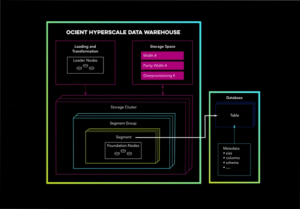
(Gorodenkoff/Shutterstock)
Fixing huge information issues typically requires creating new computing approaches and new applied sciences. However generally, the newer applied sciences and methods create further issues that didn’t beforehand exist. One upcoming huge information analytics vendor that’s discovered a contented medium balancing new tech and confirmed methods is Ocient.
Ocient was based in 2016 by a gaggle of technologists led by Chris Gladwin, who was the founding father of object storage vendor Cleversafe, which IBM purchased in 2015 for $1.4 billion. Again then, huge information lakes constructed on distributed file programs like HDFS and object storage programs like S3 had been thought of innovative. Equally, many firms had been advised that the easiest way to scale huge information workloads was to separate the compute and storage layers, which allowed them to scale independently.
Information was so large, we had been advised, that one needed to centralize the information, ideally within the cloud, and produce compute to the storage. The storage media underlying HDFS or S3–and which most cloud information warehouses, like Snowflake and Redshift, are designed to make use of–was invariably spinning disk, which even in the present day is the most cost effective type of on-line storage.
However Gladwin and his crew had a special tackle the state of affairs. They noticed the spinning disk that AWS was investing so closely in as an obstacle to progress. One might run large SQL analytics jobs by sending information throughout NICs to the storage layer, however it wouldn’t essentially be the quickest nor the most cost effective strategy.
As a substitute, Ocient developed its personal analytics database with a brand new structure that’s designed round NMVe drives. And as an alternative of separating compute and storage, Ocient’s design introduced the 2 again collectively. These two architectural design factors allowed Ocient to ship huge efficiency positive aspects on a number of the hardest huge information challenges, in response to George Kondiles, Ocient’s co-founder and chief architect.

NVMe drives maintain substantial efficiency benefits over spinning disks (ALPAL-images/Shutterstock)
“When information get very massive, within the petabytes and above, with tens to lots of of trillions of data, what we see, what we imagine to be true, is that the abstraction layer that exists between the storage and the compute is a considerable obstacle to realizing large efficiency positive aspects on the queries, comparatively talking, on that information,” Kondiles mentioned. “We work very intently with eliminating all these abstraction layers in order that we’re in a position to simply mainly discuss on to the information, learn straight from the information in situ, do as a lot of the evaluation as we will with these actually wider pipes proper off the containers on these actually massive information units.”
A typical NVMe drive can learn information at speeds as much as 3,000 MB per second and 200,000 IOPS with direct connections to the PCIe bus. A ten,000 RPM spinning disk, however, can learn information at accelerates 250 MB per second and ship perhaps 160 IOPS. When compute and storage are disconnected, as is the style, there’s further community latency.
Ocient’s concentrate on using NVMe drives gave it an enormous efficiency enhance over information lakes, which invariably use spinning disk. Whereas NVMe drives are dearer than spinning disk, they’ll entry information 30x quicker or extra, which give them an enormous efficiency benefit. For sure forms of always-on huge information workloads, the speedup that Ocient’s strategy is nicely value any additional prices that will consequence from having to purchase numerous NVMe drives and operating them in an on-prem vogue.
Again in 2016, few analytics database distributors had been creating databases with NVMe in thoughts. Ocient sensed a possibility. “We had been all in on this NVMe drive idea very early on primarily based on simply us noticing that the present database software program that was on the market wasn’t essentially capitalizing on the sort of comparatively novel capabilities that the drives have,” Kondiles advised BigDATAwire in a current interview. “And that was why we leaned in on it.”
That’s to not say that information lakes operating on object storage don’t have their place. Firms that may’t predict what their analytical wants are going to be will profit from the extra elasticity that the separation of compute and storage convey. However for sure forms of always-on OLAP workloads–the type that contain tens of petabytes of knowledge and lots of of trillions of data–the overhead incurred by accessing HDDs over the community in a knowledge lake setting is simply an excessive amount of.
“The types of issues that we’re focusing on and attempting to resolve, we see some actually substantial efficiency enhancements, price enhancements…precisely for these kinds of knowledge that the information lake strategy doesn’t essentially at all times have the perfect outcomes,” Kondiles mentioned. “In some eventualities, there’s plenty of worth available by preserving them separate. And in others, there’s plenty of worth to not essentially attempt to pressure a sq. peg in a spherical gap.”
Ocient caters to firms with a number of the largest huge information necessities, equivalent to telcos, advert tech corporations, governmental businesses, monetary companies, and enterprises with large-scale observability workloads. Lots of Ocient’s prospects run their Ocient clusters on-prem, though there’s nothing to stop the Ocient software program from being run within the cloud, which some prospects do.
Co-locating compute and storage reduces prices, however brings ancillary advantages too, Kondiles mentioned. “We had been focusing totally on efficiency and price effectiveness,” he mentioned. “But it surely’s additionally house discount and vitality discount, since you’re taking what was a bunch of storage nodes and a bunch of compute nodes and also you mix them collectively right into a single set of nodes, and the result’s decrease information middle footprint and decrease energy utilization.”
Ocient’s analytics database is constructed on the relational mannequin and makes use of normal ANSI SQL to entry information. On high of that, it provides time-series and geospatial elements, which invariably are essential within the kind of large IoT- and senor-generated information units that Ocient prospects wish to crunch. It additionally consists of some machine studying primitives that permit prospects to run predictive analytic features.
However Ocient’s database isn’t your backyard selection SQL retailer. As an illustration, the corporate has constructed erasure coding straight into its question engine, which permits it to reduce the quantity of duplicate information that prospects retailer whereas retaining the aptitude to do a full restoration within the occasion of drive losses. That’s an instance of Ocient borrowing concepts from object retailer distributors.
Right here’s one other space the place Ocient zigs whereas the remainder of the business zags: secondary indexes.
“It’s one thing that plenty of the larger names sort of moved away from simply due to the perceived complexity of managing a schema and the forms of queries and no matter else,” Kondiles mentioned. “And what we discovered is that, particularly at these scales, the secondary indexes might be essential for attaining cheap both execution occasions or prices for the system just because the information quantity is so excessive.”
Ocient has taken a realistic strategy to the way it develops its software program. It helps newer applied sciences, equivalent to NVMe and erasure encoding, whereas concurrently adopting older architectures, like secondary indexes and co-located compute and storage, when it is smart to take action.
The strategy appears to be reasoning. The corporate mentioned final week that bookings over the primary 5 months of 2025 had been almost triple the speed of final 12 months. In April, the Chicago-based firm introduced the closure of its $42.1 million Collection B spherical, bringing the corporate’s complete enterprise funding to $132 million.
The corporate is now in growth mode and looking for to develop revenues. As a part of that drive, final week Ocient introduced in John Morris to be its new CEO, changing Gladwin within the nook suite. Morris and Gladwin labored collectively beforehand at Cleversafe, the place Morris was introduced in as CEO previous to the IBM acquisition.
“I couldn’t be extra thrilled to welcome John as he takes the helm as CEO,” mentioned Gladwin, who’s now Ocient’s government chairman. “His operational and strategic management come at a pivotal time for Ocient, very like when he joined Cleversafe and helped drive tripled revenues, which resulted within the firm’s $1.4B acquisition and 10x returns for traders.
Will historical past repeat itself? Solely time will inform.
Associated Gadgets:
Hyperscale Analytics Rising Quicker Than Anticipated, Ocient Says
Ocient Report Chronicles the Rise of Hyperscale Information
The Community is the New Storage Bottleneck




